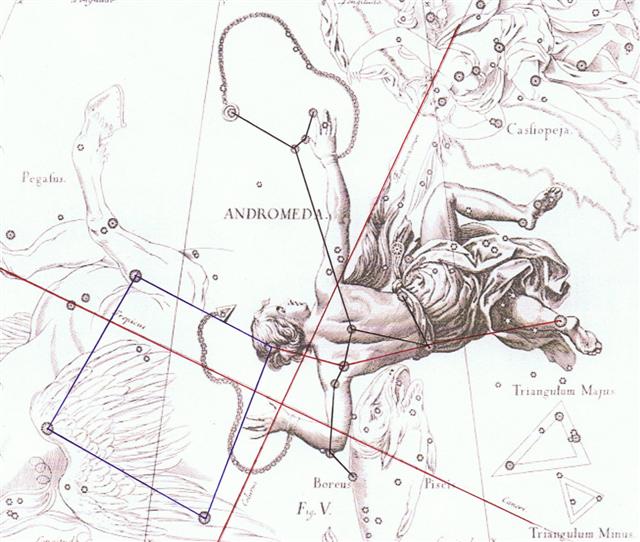5. The last 4 glyphs in line Gb7 are followed by the first 5 glyphs in line Gb8, and 4 + 5 = 9:
If Alamak can be correlated with Gb7-28, then we can imagine a composition of elements in this glyph which is based on the spread-out legs of hanau. Some kind of 'bird' seems to be born here.
When Hevelius created his picture of Andromeda he put her left arm (excepting the fingers) below (later than) and her right arm above (earlier than) the equinoctial colure (redmarked line towards Cassiopeia):
Her right (front) side is where her face is, looking up. The left (back) side of her head has Sirrah in the midst of the hair. Her left arm is formed like V and the Tropic of Cancer (also redmarked) goes through her left elbow. Alamak (at her left foot) is above 'earth' (as defined by the Tropic of Cancer) and well inside the summer half of the year. I have redmarked the line leading first from Sirrah to her shoulder (δ Andromedae, Delta) and then to Mirach at her girdle and forward in time to Alamak at her left ankle. The steady incline from Delta is obvious:
If the cycle is defined as 360 days, then there are 438¼ - 417¼ = 21 days (3 weeks) from Delta to Alamak. Counting from day number 365¼ there are 52 days (13 weeks) to Delta. This seems significant because Gb7-6 (where 7 * 6 = 42) is a Monday and the glyph type is raaraa (no Sun). There are 13 + 3 = 16 weeks from day number 365¼ to Alamak. Johannes Hevelius lived from 28 January 1611 to 28 January 1687. Since his time precession has moved spring equinox ca (2012 - 1649) / 72 = 5 days. The current location of Andromeda is not much different from what he saw. |







